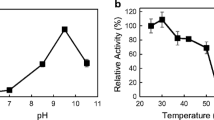Abstract
L-lactate dehydrogenase (LDH) catalyzes the interconversion of an oxoacid (pyruvate) and hydroxy-acid (lactate) using the NADH/NAD+ pair as a redox cofactor. The enzyme has a commercial significance, as it can be used to produce chiral building blocks for the synthesis of key pharmaceuticals and agrochemicals. However, the substrate inhibition which is due to an abortive NAD+-pyruvate complex reducing the steady state concentration of functional LDH limits its use in industry. This substrate inhibition can be overcome by weaking the binding of NAD+.
The conserved aspartic acid residue at position 38 was replaced by the longer basic arginine side chain (D38R) using PCR based overlap extension mutagenesis technique in the hope of weakening NAD+-binding. The mutant gene was overexpressed in theEscherichia coli high-expression vector pKK223-3 in JM105 cells; then, the mutant protein was produced. Comparing the effect of substrate inhibition in the arginine-38 mutant with wild-type, substrate inhibition is decreased threefold.
Similar content being viewed by others
References
Furlenmeier, A., Quitt, P., Vogler, K., and Lanz, P. (1976), Inventors Hoffmann La Roche Inc., assignee, USA, 3957758.
Wu, K. C., Chan, K., Lee, C. Y. G., and Lau, Y. F. (1987),Biochem. Biophys. Res. Commun. 146, 964–970.
Casy, G., Lee, T. V., and Lovell, H. (1992),Tetrahedron Lett. 33, 817–820.
Gul-Karaguler, N., \o “one-click search” Sessions, R. B., and \o “one-click search” Holbrook, J. J. (2001),Biotechnol. Lett. 23, 395–399.
Brosius, J. and Holy, A. (1984).Proc. Natl. Acad. Sci. 81, 6929–6933.
Sambrook, J., Fritsch, E. F., and Maniatis, T. (1989),Molecular Cloning—A Laboratory Manual, Second ed. Cold Spring Harbor Laboratory Press, Cold Spring Harbor, NY.
Clarke, A, R., Waldman, A. D. B., Munro, I., and Holbrook, J. J. (1985),Biochim. Biophys. Acta. 828, 375–379.
Clarke, A. R., Evington, J. R. N., Dunn, C, R., Atkinson, T., and Holbrook, J. J. (1986),Biochim. Biophys. Acta. 870, 112–126.
Fromm, H. J. (1961),Biochim. Biophys. Acta. 52, 199–200.
Gutfreund, H., Cantwell, R., McMurray, C. H., Criddle, R. S., and Hathaway, G. (1968),Biochem. J. 106, 683–687.
Coulson, C. J. and Rabin, B. R. (1969),FEBS Lett. 3, 333–334.
Eszes, C. M., Sessions, R. B., Clarke, A. R., Moreton, K. M., and Holbrook, J. J. (1996),FEBS Lett. 399, 193–197.
Hewitt, C. O., Sessions, R. B., Dafforn, T. R., and Holbrook, J. J. (1997),Prot. Eng. 10, 39–41.
Hewitt, C. O., Eszes, C. M., Sessions, R. B., et al. (1999),Prot. Eng. 12, 491–496.
Holbrook, J. J., Liljas, A., Steindel, S. J., and Rossmann, M. G. (1975), inThe Enzymes, vol. 11a (Boyer, P.D., ed.). Academic, New York: pp. 191–292.
Feeney, R., Clarke, A. R., and Holbrook, J. J. (1990),Biochim. Biophys. Res. Commun. 166, 667–672.
Tyagi, R., Lai, R., and Duggleby, R. G. (2004),BMC Biotechnol. 4, 2.
Ke, S. H. and Madison, E. L. (1997),Nucleic Acids Res. 25, 3371–33722.
Ho, S. N., Hunt, H. D., Horton, R. M., Pullen, J. K., and Pease, L. R. (1989),Gene 77, 51–59.
Karaguler, N. G., Sessions, R. B., Moreton, K. M., Clarke, A. R., and Holbrook, J. J. (2004),Biotechnol. Lett. 26, 1137–1140.
Author information
Authors and Affiliations
Corresponding author
Rights and permissions
About this article
Cite this article
Binay, B., Karagüler, N.G. Attempting to remove the substrate inhibition ofL-lactate dehydrogenase fromBacillus stearothermophilus by site-directed mutagenesis. Appl Biochem Biotechnol 141, 265–272 (2007). https://doi.org/10.1007/BF02729067
Received:
Revised:
Accepted:
Issue Date:
DOI: https://doi.org/10.1007/BF02729067




